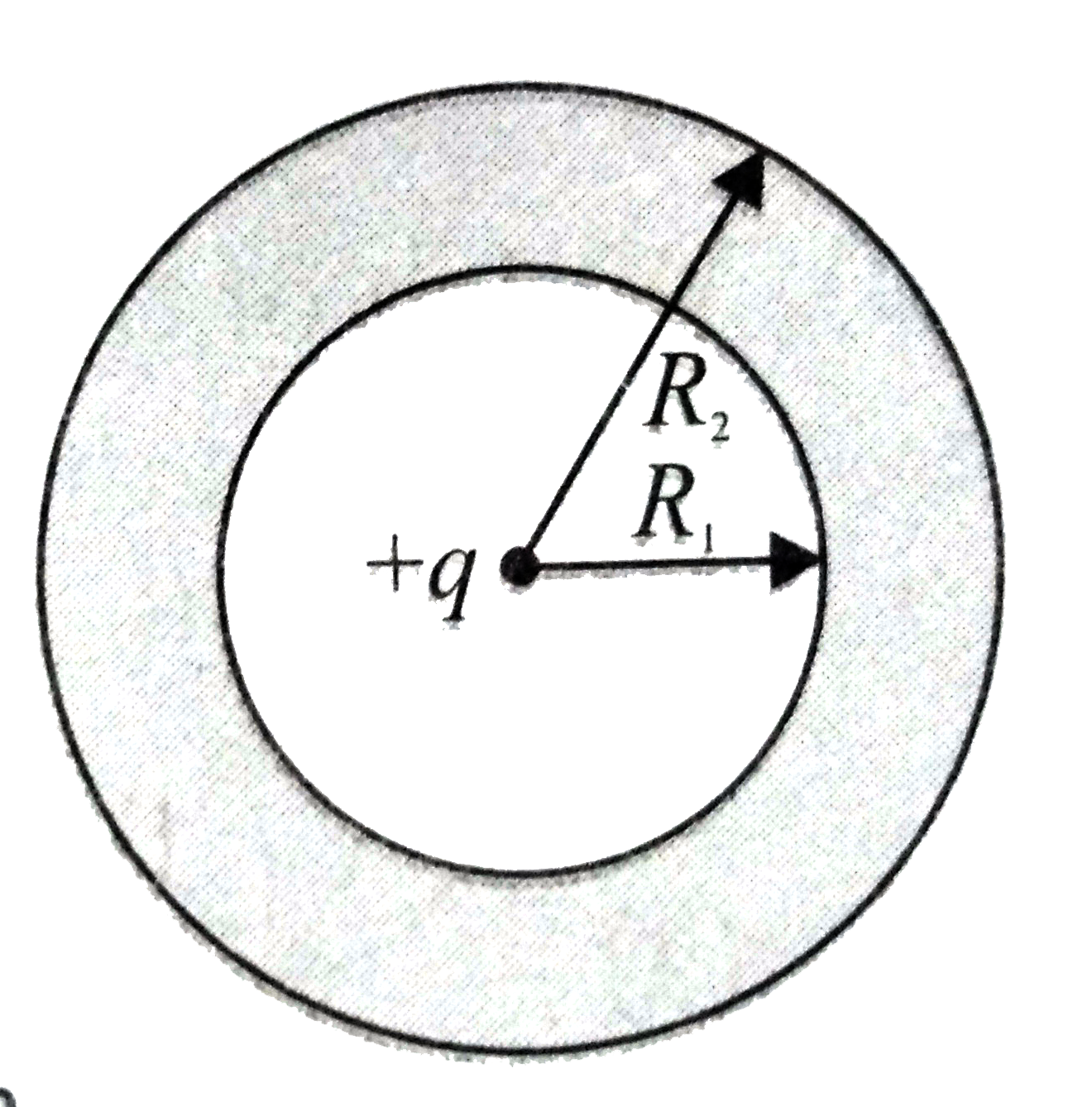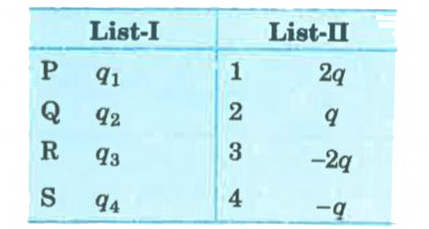A chance Q placed at thee center of a metallic spherical shell with inner and outer radii R1andR2 respectively . The normal component of the electric field at any point on the Gaussian surface with radius between R1andR2 will be
Zero
Q4πR21
Q4πR22
Q4π(R1−R2)2
The correct Answer is:A
To solve the problem, we need to analyze the situation involving a charge Q placed at the center of a metallic spherical shell with inner radius R1 and outer radius R2. We want to find the normal component of the electric field at any point on a Gaussian surface with a radius between R1 and R2.
1. Understanding the Setup:
- We have a metallic spherical shell with a charge Q at its center. The inner radius of the shell is R1 and the outer radius is R2.
- The region we are interested in is the space between R1 and R2.
2. Applying Gauss's Law:
- According to Gauss's Law, the electric flux ΦE through a closed surface is proportional to the charge enclosed by that surface:
ΦE=Qencϵ0
- Here, Qenc is the charge enclosed by the Gaussian surface.
3. Choosing the Gaussian Surface:
- We choose a spherical Gaussian surface of radius r such that R1<r<R2.
- Since the charge Q is at the center, the entire charge Q is enclosed by this Gaussian surface.
4. Calculating the Electric Field:
- The electric field E at a distance r from the center is uniform over the Gaussian surface and points radially outward.
- The area A of the Gaussian surface is given by:
A=4πr2
- The electric flux through the Gaussian surface is:
ΦE=E⋅A=E⋅4πr2
- Setting the electric flux equal to the charge enclosed divided by ϵ0:
E⋅4πr2=Qϵ0
- Solving for E:
E=Q4πϵ0r2
5. Finding the Normal Component of the Electric Field:
- The normal component of the electric field at any point on the Gaussian surface is the component of E that is perpendicular to the surface.
- Since the electric field E is directed radially outward and the normal to the surface is also radial, the angle between them is 0∘.
- Therefore, the normal component of the electric field is:
En=E⋅cos(0∘)=E
- However, we need to consider the electric field inside the conductor (metallic shell). Inside a conductor in electrostatic equilibrium, the electric field is zero.
6. Conclusion:
- Thus, the normal component of the electric field at any point on the Gaussian surface between R1 and R2 is:
En=0
Final Answer:
The normal component of the electric field at any point on the Gaussian surface with radius between R1 and R2 is zero.
- We have a metallic spherical shell with a charge Q at its center. The inner radius of the shell is R1 and the outer radius is R2.
- The region we are interested in is the space between R1 and R2.
- According to Gauss's Law, the electric flux ΦE through a closed surface is proportional to the charge enclosed by that surface:
ΦE=Qencϵ0
- Here, Qenc is the charge enclosed by the Gaussian surface.
- We choose a spherical Gaussian surface of radius r such that R1<r<R2.
- Since the charge Q is at the center, the entire charge Q is enclosed by this Gaussian surface.
- The electric field E at a distance r from the center is uniform over the Gaussian surface and points radially outward.
- The area A of the Gaussian surface is given by:
A=4πr2
- The electric flux through the Gaussian surface is:
ΦE=E⋅A=E⋅4πr2
- Setting the electric flux equal to the charge enclosed divided by ϵ0:
E⋅4πr2=Qϵ0
- Solving for E:
E=Q4πϵ0r2
- The normal component of the electric field at any point on the Gaussian surface is the component of E that is perpendicular to the surface.
- Since the electric field E is directed radially outward and the normal to the surface is also radial, the angle between them is 0∘.
- Therefore, the normal component of the electric field is:
En=E⋅cos(0∘)=E
- However, we need to consider the electric field inside the conductor (metallic shell). Inside a conductor in electrostatic equilibrium, the electric field is zero.
- Thus, the normal component of the electric field at any point on the Gaussian surface between R1 and R2 is:
En=0
The normal component of the electric field at any point on the Gaussian surface with radius between R1 and R2 is zero.
Topper's Solved these Questions
Similar Questions
What is the volume of the material in a spherical shell with inner radius ‘r' and outer radius 'R' ?
View SolutionA metallic spherical shell has an inner radius R1 and outer radius R2. A charge is placed at the centre of the spherical cavity. The surface charge density on the inner surface is

View Solution
Knowledge Check
A positive charge Q is placed at the centre O of a thin metalic spherical shell. Select the correct statements from the following:
(i) The electric field at any point outside the shell is zero
(ii) The electrostatic potential at any point outside the shell is Q4πε0r , where r is the distance of the point from O
(iii) The outer surface of the spherical shell is an equipotential surface
(iv) The electric field at any point inside the shell , other than O , is zeroA(i),(ii)B(ii),(iii)C(i),(iv)DallThere are three concentric metallic spherical shells of radii R, 2R and 3q, respectively. The middle spherical shell is connected to earth. Let q1 be the charge appearing on the inner surface of the middle sphere and q2 be the charge on outer surface of the middle sphere. Similarly q3 is the charge appearing on inner surface of outermost sphere and q4 is the charge appearing on outer surface of outermost sphere.
 APQRS4312BPQRS4321CPQRS3412DPQRS3421
APQRS4312BPQRS4321CPQRS3412DPQRS3421A point charge Q is located at the centre of a hollow spherical conductor having inner radius as R1 and outer radius R2. The conductor being uncharged initially. The potential at the inner surface will be
AKQ[1R1+1R2]BKQ[1R1−1R2]CKQ[1R2−1R1]Dnone of these
A point charge +q is placed at the centre of a conducting spherical shell of inner radius a and outer radius b. Find the charge appearing on the inner and outer surface of the shell.
View SolutionA point charge Q is placed inside a conducting spherical shell of inner radius 3R and outer radius 5R at a distance R from the centre of the shell. The electric potential at the centre of the shell will be
View SolutionA metalic spherical shell has an inner radius R1and outer radius R2 . A charge Q is placed at the centre of the spherical cavity. What will be surface charge density on (i) the inner surface and (ii) the outer surface?
View SolutionA point charge q is placed at a distance of r from the centre O of an uncharged spherical shell of inner radius R and outer radius 2R. The electric potential at the centre of the shell will be

View SolutionThe capacitance of two concentric spherical shells of radii R1 and R2(R2>R1) is
View Solution
